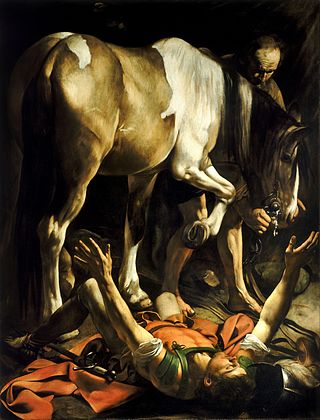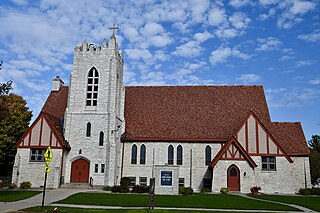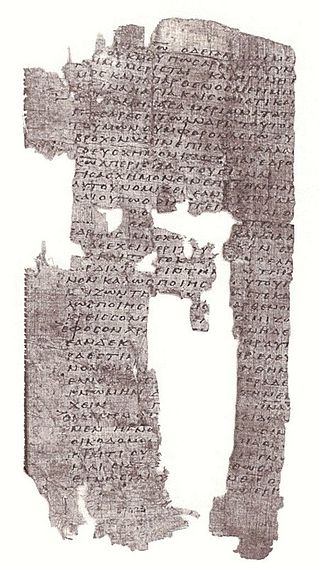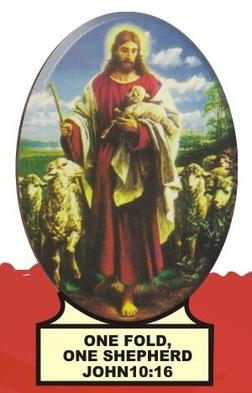Related Research Articles

The First Epistle to the Corinthians is one of the Pauline epistles, part of the New Testament of the Christian Bible. The epistle is attributed to Paul the Apostle and a co-author, Sosthenes, and is addressed to the Christian church in Corinth. Scholars believe that Sosthenes was the amanuensis who wrote down the text of the letter at Paul's direction. It addresses various issues that had arisen in the Christian community at Corinth and is composed in a form of Koine Greek.

Paul, commonly known as Paul the Apostle and Saint Paul, was a Christian apostle who spread the teachings of Jesus in the first-century world. Generally regarded as one of the most important figures of the Apostolic Age, he founded several Christian communities in Asia Minor and Europe from the mid-40s to the mid-50s AD.

The resurrection of Jesus is the Christian belief that God raised Jesus from the dead on the third day after his crucifixion, starting – or restoring – his exalted life as Christ and Lord. According to the New Testament writing, Jesus was firstborn from the dead, ushering in the Kingdom of God. He appeared to his disciples, calling the apostles to the Great Commission of forgiving sin and baptizing repenters, and ascended to Heaven.

Seventh Day Baptists are Baptists who observe the Sabbath as the seventh day of the week, Saturday, as a holy day to God. They adopt a covenant Baptist theology, based on the concept of regenerated society, conscious baptism of believers by immersion, congregational government and the scriptural basis of opinion and practice. They profess a statement of faith instituted on fundamental precepts of belief. Seventh Day Baptists rest on Saturday as a sign of obedience in a covenant relationship with God and not as a condition of salvation.

The Last Judgment, Final Judgment, Day of Reckoning, Day of Judgment, Judgment Day, Doomsday, Day of Resurrection or The Day of the Lord is part of the Abrahamic religions and the Frashokereti of Zoroastrianism.

Mark 16 is the final chapter of the Gospel of Mark in the New Testament of the Christian Bible. Christopher Tuckett refers to it as a "sequel to the story of Jesus' death and burial". The chapter begins after the sabbath has ended, with Mary Magdalene, Mary the mother of James, and Salome purchasing spices to bring to the tomb next morning to anoint Jesus' body. There they encounter the stone rolled away, the tomb open, and a young man dressed in white who announces the resurrection of Jesus (16:1-6). The two oldest manuscripts of Mark 16 conclude with verse 8, which ends with the women fleeing from the empty tomb, and saying "nothing to anyone, because they were too frightened".

In Christianity, Jesus is the Son of God as written in the Bible's New Testament, and in mainstream Christian denominations he is God the Son, the second Person in the Trinity. Christians believe him to be the Jewish messiah prophesied in the Hebrew Bible. Through Jesus's crucifixion and resurrection, God reputedly offers humans salvation and eternal life, with Jesus's death atoning for all sin, thus making humanity right with God.
The Congregational Holiness Church is a Holiness Pentecostal Christian denomination that was formed in 1921.

The life of Jesus is primarily outlined in the four canonical gospels, which includes his genealogy and nativity, public ministry, passion, prophecy, resurrection and ascension. Other parts of the New Testament – such as the Pauline epistles which were likely written within 20 to 30 years of each other, and which include references to key episodes in the life of Jesus, such as the Last Supper, and the Acts of the Apostles, which includes more references to the Ascension episode than the canonical gospels also expound upon the life of Jesus. In addition to these biblical texts, there are extra-biblical texts that Christians believe make reference to certain events in the life of Jesus, such as Josephus on Jesus and Tacitus on Christ.
Kerygma is a Greek word used in the New Testament for "proclamation". It is related to the Greek verb κηρύσσω (kērússō), literally meaning "to cry or proclaim as a herald" and being used in the sense of "to proclaim, announce, preach". Amongst biblical scholars, the term has come to mean the core of the early church's teaching about Jesus.
The non-canonical books referenced in the Bible includes non-Biblical cultures, and lost works of known or unknown status. By the "Bible" is meant those books recognized by most Christians and Jews as being part of Old Testament as well as those recognized by some Christians as being part of the Biblical apocrypha or of the Deuterocanon.

The post-tribulation rapture doctrine is the belief in a combined resurrection and gathering of the saints coming is after the Great Tribulation.

Matthew 19 is the nineteenth chapter in the Gospel of Matthew in the New Testament section of the Christian Bible. The book containing this chapter is anonymous, but early Christian tradition uniformly affirmed that Matthew composed this Gospel. Jesus commences his final journey to Jerusalem in this chapter, ministering through Perea. It can be seen as the starting point for the passion narrative.
This is a calendar of saints list for the Armenian Apostolic Church.

1 Corinthians 15 is the fifteenth chapter of the First Epistle to the Corinthians in the New Testament of the Christian Bible. It is authored by Paul the Apostle and Sosthenes in Ephesus. The first eleven verses contain the earliest account of the post-resurrection appearances of Jesus in the New Testament. The rest of the chapter stresses the primacy of the resurrection for Christianity.

1 Corinthians 5 is the fifth chapter of the First Epistle to the Corinthians in the New Testament of the Christian Bible. It is authored by Paul the Apostle and Sosthenes in Ephesus. In this short chapter, Paul deals with an issue of sexual immorality in the Corinthian church.

The Apostolic Church Nigeria is a Pentecostal Christian denomination in Nigeria with its national headquarters at Olorunda Ketu, Lagos and international headquarters in Penygroes, UK.
In Christianity, the title Son of God refers to the status of Jesus as the divine son of God the Father. In Trinitarian Christianity, it also refers to his status as God the Son, the second Person of the Trinity or hypostasis of the Trinity.
This is a list of the sermons of John Wesley, founder of Methodism. The first four volumes of Wesley's sermons include 44 discourses that are of special significance, while later volumes are also studied by Methodists for their doctrinal and moral teachings.
References
- ↑ 16:1–4
- ↑ 28:1
- ↑ 23:55–56, 24:1
- ↑ 24:2–3
- ↑ 20:1
- ↑ 20:2–10
- ↑ 16:6
- ↑ 28:2–7
- ↑ 24:4–5
- ↑ 20:11–13
- ↑ 16:7
- ↑ 28:7
- ↑ Mark 16:8
- ↑ 24:9–12
- ↑ Mark 16:8
- ↑ 28:9–10
- ↑ 20:11–18
- ↑ 16:9–11
- ↑ 24:13–31
- ↑ 16:12
- ↑ 1 Corinthians 15:5–7
- ↑ 24:36–50
- ↑ 1:3
- ↑ 20:19–31
- ↑ 16:14–18
- ↑ Mark 16:8
- ↑ 28:16–20
- ↑ 21:1–22
- ↑ 1:4–8
- ↑ 24:51
- ↑ 1:9–11
- ↑ 16:19
- ↑ 1 Corinthians 15:8